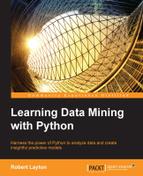Rather than just returning the given prediction, we can check whether the word actually exists in our dictionary. If it does, then that is our prediction. If it isn't in the dictionary, we can try and find a word that is similar to it and predict that instead. Note that this strategy relies on our assumption that all CAPTCHA words will be valid English words, and therefore this strategy wouldn't work for a random sequence of characters. This is one reason why some CAPTCHAs don't use words.
There is one issue here—how do we determine the closest word? There are many ways to do this. For instance, we can compare the lengths of words. Two words that have a similar length could be considered more similar. However, we commonly consider words to be similar if they have the same letters in the same positions. This is where the edit distance comes in.
The Levenshtein edit distance is a commonly used method for comparing two short strings to see how similar they are. It isn't very scalable, so it isn't commonly used for very long strings. The edit distance computes the number of steps it takes to go from one word to another. The steps can be one of the following three actions:
- Insert a new letter into the word at any position.
- Delete any letter from the word.
- Substitute a letter for another one.
The minimum number of actions needed to transform the first word into the second is given as the distance. Higher values indicate that the words are less similar.
This distance is available in NLTK as nltk.metrics.edit_distance. We can call it using on two strings and it returns the edit distance:
from nltk.metrics import edit_distance
steps = edit_distance("STEP", "STOP")
print("The number of steps needed is: {0}".format(steps))When used with different words, the edit distance is quite a good approximation to what many people would intuitively feel are similar words. The edit distance is great for testing spelling mistakes, dictation errors, and name matching (where you can mix up your Marc and Mark spelling quite easily).
However, it isn't very good. We don't really expect letters to be moved around, just individual letter comparisons to be wrong. For this reason, we will create a different distance metric, which is simply the number of letters in the same positions that are incorrect. The code is as follows:
def compute_distance(prediction, word):
return len(prediction) - sum(prediction[i] == word[i] for i in range(len(prediction)))We subtract the value from the length of the prediction word (which is four) to make it a distance metric where lower values indicate more similarity between the words.
We can now test our improved prediction function using similar code to before. First we define a prediction, which also takes our list of valid words:
from operator import itemgetter
def improved_prediction(word, net, dictionary, shear=0.2):
captcha = create_captcha(word, shear=shear)
prediction = predict_captcha(captcha, net)
prediction = prediction[:4]Up to this point, the code is as before. We do our prediction and limit it to the first four characters. However, we now check if the word is in the dictionary or not. If it is, we return that as our prediction. If it is not, we find the next nearest word. The code is as follows:
if prediction not in dictionary:
We compute the distance between our predicted word and each other word in the dictionary, and sort it by distance (lowest first). The code is as follows:
distances = sorted([(word, compute_distance(prediction, word))
for word in dictionary], key=itemgetter(1))We then get the best matching word—that is, the one with the lowest distance—and predict that word:
best_word = distances[0]
prediction = best_word[0]We then return the correctness, word, and prediction as before:
return word == prediction, word, prediction
The changes in our testing code are highlighted in the following code:
num_correct = 0
num_incorrect = 0
for word in valid_words:
correct, word, prediction = improved_prediction(word, net, valid_words, shear=0.2)
if correct:
num_correct += 1
else:
num_incorrect += 1
print("Number correct is {0}".format(num_correct))
print("Number incorrect is {0}".format(num_incorrect))The preceding code will take a while to run (computing all of the distances will take some time) but the net result is 3,037 samples correct and 2,476 samples incorrect. This is an accuracy of 55 percent for a boost of 4 percentage points. The reason this improvement is so low is that multiple words all have the same similarity, and the algorithm is choosing the best one randomly between this set of most similar words. For example, the first word in the list, AANI (I just chose the first word in the list, which is a dog-headed ape from Egyptian mythology), has 44 candidate words that are all the same distance from the word. This gives just a 1/44 chance of choosing the correct word from this list.
If we were to cheat and count the prediction as correct if the actual word was any one of the best candidates, we would rate 78 percent of predictions as correct (to see this code, check out the code in the bundle).
To further improve the results, we can work on our distance metric, perhaps using information from our confusion matrix to find commonly confused letters or some other improvement upon this. This iterative improvement is a feature of many data mining methodologies, and it mimics the scientific method—have an idea, test it out, analyze the results, and use that to improve the next idea.
